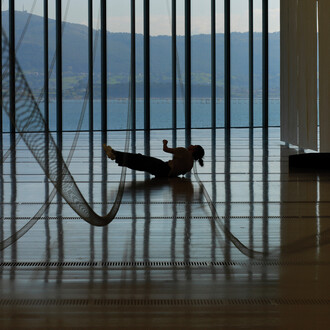Observing daily life and discovering something special comes naturally to me.
(Shimabuku)
The practice of Shimabuku (1969, Kobe, Japan) is firmly grounded in relationships, rather than creating specific objects. His affective and often humorous works are prompted by an anecdote, a conversation, a trip to a new place or the artist’s own curiosity, and are developed through experiments with humans, animals or other beings that take place in natural and public spaces. These experiments suggest an empathetic and candid way of being in the world, following a simple “What if I…?” dare. This curiosity-led approach takes us back to childhood, when exploring the unexpected is vital to development and learning
Octopus, citrus, human features video, photography, sculpture, installation, and text works spanning from the early 1990s until today. The exhibition also premieres three newly commissioned works produced by Fundación Botín that involve local communities, both human and non-human. The title of the show reflects on each new work: an offering for octopuses, water tanks for floating and sinking citruses, and many kites for many humans. These open-ended encounters are documented and made public in exhibitions like this one, where conventions between nature/culture, process/artwork, audience/collaborator are playfully overturned.
The exhibition opens with Flying people (Santander), 2024, an installation composed of many kites handmade by locals in collaboration with Shimabuku. The work is displayed alongside a video that shows the collective flight of the kites in the amphitheatre outside Centro Botín. The piece continues with a series of his first photographic works–Tour of Europe with one eyebrow shaved, 1991; Symbiosis (hyacinth and black gold fish) 1992; Christmas in the southern hemisphere, 1994; and Sitting on the wave, 1998, which testify to the nomadic and ephemeral approach of his artistic creation.
Shimabuku’s works emerge from the artist’s own curiosity, manifesting themselves in variations through multiple experiments, adapting to new contexts and ecologies. Exhibition for the monkeys, 1992, presents video and photographs documenting the descendants of Japanese macaques that were transported to a desert sanctuary in Texas for a science experiment in 1972. Also on display is Shimabuku’s fish and chips, 2006, which documents the meeting of the ingredients of the quintessential British dish, showing a potato embarking on an underwater journey through Liverpool to meet a fish.
Since the 90s, Shimabuku has developed a body of work in relation to octopuses that includes works such as Encounter between an octopus and a pigeon: if gravity disappeared from the earth, then an octopus and a pigeon could meet in all fairness. Fighting with gravity, 1993; Then, I decided to give a tour of Tokyo to the octopus from Akashi, 2000; and Catching octopus with self-made ceramic pots, 2003. For this exhibition, the artist placed 50 glass vessels at the bottom of Santander bay to film how the animals interacted with them, which led to the video Going to meet the octopuses in Santander, 2024.
The exhibition ends with the new installation Something that floats / something that sinks, 2024, which consists of a series of water tanks where a selection of autumn citrus fruits ‘float or sink’. The fruit was provided by the Todolí Citrus Foundation, a non-profit organisation created for the study and dissemination of citrus fruits and citriculture.
Shimabuku: octopus, citrus, human is accompanied by a publication, co-published by La Fábrica, with texts by researcher Filipa Ramos and artist Philippe Parreno, alongside a conversation between the artist and the co-curator Bárbara Rodríguez Muñoz.
Shimabuku (Born in Kobe, Japan 1969. Lives in Naha, Okinawa, Japan). Recent solo exhibitions include Kunsthalle Bern (2014), NMNM Nouveau Musée National de Monaco (2021), Wiels, Brussels, Belgium (2022) and Museion: Museum of modern and contemporary art, Bolzano, Italy (2023). Group exhibitions include, Centre Pompidou in Paris and Hayward Gallery in London, and in numerous international exhibitions including Venice Biennale (2003 and 2017), the São Paulo Biennial (2006), Havana Biennal (2015) and Lyon Biennale (2017).













